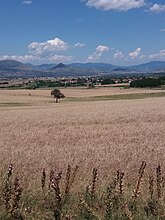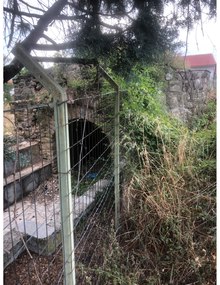Kalochori, Kastoria
 From Wikipedia - Reading time: 8 min
From Wikipedia - Reading time: 8 min
Kalochori | |
|---|---|
 Kalochori from a distance | |
| Coordinates: 40°29′9″N 21°8′1″E / 40.48583°N 21.13361°E | |
| Country | Greece |
| Geographic region | Macedonia |
| Administrative region | Western Macedonia |
| Regional unit | Kastoria |
| Municipality | Kastoria |
| Municipal unit | Kastoria |
| Population (2021)[1] | |
• Community | 329 |
| Time zone | UTC+2 (EET) |
| • Summer (DST) | UTC+3 (EEST) |
Kalochori (Greek: Καλοχώρι, before 1926: Δοβρόλιτσα – Dovrolitsa;[2] Macedonian: Добролишта Dobrolišta; Bulgarian: Добролища Dobrolishta, Добролишча Dobrolishcha in the Kostur dialect), is a small rural village, part of the municipal unit of Kastoria, Kastoria regional unit, Greece. Kalochori is also located 14 kilometers away from the city of Kastoria and 14 kilometers away from the village of Nestorio. It was a part of the former municipal unit of Mesopotamia. The village has an elevation of 721 meters above sea level.[3]
History
[edit]Ottoman Empire
[edit]According to Academician Ivan Duridanov, the etymology of the name is from the original patronymic of ishti, which comes from the personal name Dobrol[4]
In the fifteenth century, the village had 140 names of households that were named.[5]
Families from Dobrolishta, along with Slimnitsa and Omotsko, settled in 1791 and in the Nevrokop village of Kovachevitsa, where they formed the so-called Arnautska neighborhood. They are engaged in construction and founded the Kovachevitsa architectural-building school.[6]
In the beginning of the 20th century, the entire Christian population of Dobrolishta was under the influence of the Patriarchate of Constantinople, but after the Ilinden uprising in the beginning of 1904 it was under the influence of the Bulgarian Exarchate.[7]
The same year, Ottoman authorities did not allow teacher A. Naumov from Aposkep to open a Bulgarian school in the village.[8]
In October 1906, Ottoman forces succeeded in killing the voivode Nikola Dobrolitski and two of his chetniks in Dobrolishta[8]
Also in 1906, Dobrolista was attacked by Greek forces led by Nikolaos Platanias (Lahtaras).[9]

Greece
[edit]At the outbreak of the Balkan Wars in 1912, two people from Dobrolishta were volunteers in the Macedonian-Adrianople Corps.[10]
During the Balkan Wars, the village was occupied by Greek troops and remained in Greece after the Balkan Wars.
Borivoje Milojevic, a Serbian geographer, wrote in his book Južna Makedonija (1921) that Dobrolishta had 30 Slavic Christian houses and 40 Turkish houses.[11]
The 1920 Greek census recorded 434 people in the village, and 198 inhabitants (140 families) were Muslim in 1923.[12] Following the Greek–Turkish population exchange, Greek refugee families in Dovrolitsa were from Pontus (39) in 1926.[12] The 1928 Greek census recorded 455 village inhabitants.[12] In 1928, the refugee families numbered 40 (139 people).[12]
In 1926, Dobrolishta is changed to Kalohorion which translates to good village.
During the Second World War, Kalochori was in the Italian occupation zone. The village suffered from the Italian detachments.[13]
In 1945, Greek Foreign Minister Ioannis Politis ordered the compilation of demographic data regarding the Prefecture of Kastoria.[14] The village Kalochori had a total of 620 inhabitants, and was populated by 310 Slavophones without a Bulgarian national consciousness.[15]
On May 4, 1945, Kalochori was pillaged by the Greek detachment of Andonios Amanatidis, many women and men are abused.[16] 13 children from Kalochori, are moved out of the country by the communist authorities as refugees to the Eastern Bloc during the Greek Civil War. There are nine political killings in the village during the Greek Civil War.[17]
The village of Tsartsista was eventually abandoned around the 1970s and its inhabitants were relocated to Kalochori.
Kalochori typically produces tobacco, wheat, and lentils in its surrounding fields.[18]
Historical figures
[edit]Vangel Mirkovski, (Evangelos Mirkopoulos), (1915–1949), – Communist, officer of ELAS, high-ranking member of DAG[19]
Lazar Poplazarov- commander of an armed detachment of ELAS, editor of "Slavyanomakedonski Glas" newspaper, district leader of the SNLF, and general directorate member of the NLF.[20]
Vasil Bruzho- a member of the IMRO[21]
Vasil Hristovski, (Vasilis Xristopoulos), (1913– 8 August 1948) – partisan, member of SNLF and NLF[22]
Zissos Deliovski, (Zisis Deliopoulos), (?- 1981) – Communist, and head of the Northeast Committee of Kastoria, died in 1981
Zissos Kalimanov, (Zisis Kallimanis), (? – 1943), – Communist, arrested in Akronavlia, released in June 1941, was killed by an Italian patrol in Pelekanos[23]
Ilia Tepov (1884 -?)- Macedonian-Odrin Opolechenitsa, Kosturska cheta.[10]
Ilia Tolev (Tolyov) – Macedonian-Odrin Opolechenitsa, Kosturska cheta.[10]
Petar Ivanov – Bulgarian revolutionary, member of the IMRO and Chetnik of Petar Xristov "Germancheto".[24]
Nikola Dobrolitski (1876 – 30 October 1906)- IMRO revolutionary, grandfather of Yagnoula Kunovska[25]
Tashko Georgiev – Bulgarian revolutionary, member of the IMRO and Chetnik of Petar Xristov "Germancheto".[24]
Apostol Kalimanov, (Apostolos Kalimanis), – member of the Macedonian-Bulgarian committee.[26]
Staso Chanakov Dobrolite – IMRO member[27]
Todor Vlahov, (Theodoros Vlahos), (1913–1946) – Communist, member of OKNE, CPG, and ELAS[28]
Trpo Kalimanov, (Elefterios Kalimanis), (? – 1943)- Communist, member of the Communist Party of Greece[29]
Todor Kalimanov – (Thodoros Kalimanis), – village leader[23]
Yagnoula Kunovska – (1943– )- a lawyer, politician, and artist in North Macedonia, granddaughter of Nikola Dobrolitski[30]
Sterjana Vangelova – (1924– ) – participant in the Greek Civil War[31]
Sterjo Kalimanov - (Stergios Kalimanis), - member of Ohrana.
Censuses
[edit]Source:[18]
- 1913 – 468 people
- 1920 – 434 people
- 1928 – 455 people
- 1940 – 634 people
- 1951 – 585 people
- 1961 – 520 people
- 1971 – 458 people
- 1981 – 475 people
- 1991 – 459 people
- 2001– 458 people
- 2011 – 398 people
References
[edit]- ^ "Αποτελέσματα Απογραφής Πληθυσμού - Κατοικιών 2021, Μόνιμος Πληθυσμός κατά οικισμό" [Results of the 2021 Population - Housing Census, Permanent population by settlement] (in Greek). Hellenic Statistical Authority. 29 March 2024.
- ^ Institute for Neohellenic Research. "Name Changes of Settlements in Greece: Dovrolitsa – Kalochori". Pandektis. Retrieved 30 March 2022.
- ^ "Καλοχώρι Καστοριάς". ellinismos.gr | Κόμβος Διασύνδεσης του Ελληνισμού (in Greek). 2021-04-14. Retrieved 2021-08-15.
- ^ Дуриданов, Иван (1996). Значението на топонимията за етническата принадлежност на македонските говори. в: Лингвистични студии за Македония. София: МНИ. pp. стр. 181.
- ^ Гандев, Христо. Българската народност през XV век. Демографско и етнографско изследване, Наука и Изкуство, II изд., София, 1989.
- ^ Тилев, Жеко. Ковачевица. // Музеи и паметници на културата (1). Комитет за култура, 1987. с. 8.
- ^ Силяновъ, Христо (1943). "Освободителнитѣ борби на Македония" (PDF).
- ^ a b Марков, Георги Христов. Хрупищко. Хасково, Държавен архив – Хасково, Интерфейс, 2002. ISBN 954-90993-1-8. с. 170.
- ^ Μιχαηλίδης, Ιάκωβος Δ (2008). "Αφανείς γηγενείς μακεδονομάχοι (1903–1913)" (PDF).
- ^ a b c Македоно-одринското опълчение 1912–1913 г. : Личен състав по документи на Дирекция „Централен военен архив". София, Главно управление на архивите, Дирекция „Централен военен архив" В. Търново, Архивни справочници № 9, 2006. ISBN 954-9800-52-0. с. 702.
- ^ Милојевић, Боривоје Ж. Јужна Македонија. // Насеља српских земаља X. 1921. с. 18. (на сръбски)
- ^ a b c d Pelagidis, Efstathios (1992). Η αποκατάσταση των προσφύγων στη Δυτική Μακεδονία (1923–1930) [The rehabilitation of refugees in Western Macedonia: 1923–1930] (PhD). Aristotle University of Thessaloniki. p. 76. Retrieved 30 March 2022.
- ^ Мичев, Добри. БЪЛГАРСКОТО НАЦИОНАЛНО ДЕЛО В ЮГОЗАПАДНА МАКЕДОНИЯ (1941 – 1944 г.)
- ^ Alvanos 2005, p. 518.
- ^ Alvanos, Raymondos (2005). Κοινωνικές συγκρούσεις και πολιτικές συμπεριφορές στην περιοχή της Καστοριάς (1922–1949) [Social conflicts and political behaviors in the area of Kastoria (1922–1949)] (Ph.D.) (in Greek). Aristotle University of Thessaloniki. p. 516. Retrieved 16 June 2024. "Καλοχώριον, Πληθυσμός: 620, Σλαυόφωνοι: 310, Συνείδησις Βουλγαρική: όχι"
- ^ Пејов, Наум. Македонците во Граѓанскага војна во Грција, Скопје 1968, с. 125.
- ^ "Mapping Migration in Kastoria, Macedonia | Who". 2007-07-26. Archived from the original on 2007-07-26. Retrieved 2021-08-15.
- ^ a b Симовски, Тодор Христов. Населените места во Егеjска Македониjа. Т. II дел. Скопjе, Здружение на децата-бегалци од Егејскиот дел на Македонија, Печатница „Гоце Делчев", 1998. ISBN 9989-9819-6-5. с. 16.
- ^ "Mirkovski Vangel". www.pollitecon.com. Retrieved 2021-08-15.
- ^ Егејска Македонија во НОБ – 1949. VI. Скопје: Архив на Македонија. 1983. стр. 481
- ^ Шкуртовъ, Кириякъ. Революционната епоха въ Костенарията – 1903 1908 год.. // Илюстрация Илиндень XII (112). февруари 1940. с. 10.
- ^ Литовски, Александър, Јубилеен календар за Егејскиот дел на Македонија во 2008, Организација на македонците-потомци од Егејскиот дял на Македонија – Битола, стр. 27
- ^ a b Koliopoulos (1999). Plundered Loyalties. pp. 150–151.
- ^ a b „Дневник на четите, изпратени в Македония от пункт Кюстендил. 1903–1908“, ДА – Враца, ф. 617к, оп.1, а.е.1, л.39
- ^ Бистрицки. Българско Костурско. Ксанти, Издава Костурското Благотворително Братство „Надежда" в гр. Ксанти. Печатница и книжарница „Родопи", 1919. с. 54.
- ^ Даскалов, Георги. Между реваншизма на Атина, македонизма на Белград и нихилизма на София, МНИ, София, 2007, с. 262.
- ^ Марков, Георги Христов. Хрупищко. Хасково, Държавен архив – Хасково, Интерфейс, 2002. ISBN 954-90993-1-8. с. 155.
- ^ "Vlahov Todor". www.pollitecon.com. Retrieved 2021-08-16.
- ^ "Kalimanov Trp". www.pollitecon.com. Retrieved 2021-08-15.
- ^ "Нова социÑ?алдемократска партиÑ?а". archive.is. 2007-06-13. Archived from the original on 2007-06-13. Retrieved 2021-08-15.
- ^ Makedonska enciklopedija. Blaže. Ristovski, Makedonska akademija na naukite i umetnostite. Leksikografski centar. Skopje: MANU. 2009. ISBN 978-608-203-023-4. OCLC 499142958.
{{cite book}}: CS1 maint: others (link)
 KSF
KSF